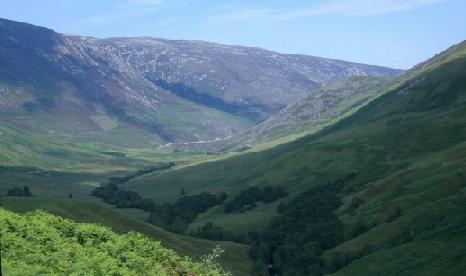
My [3 minute] Testimony to the Committee of the Full Board of Education
Opposing Proposed Amendments to 19 TAC Chapter 112 (TEKS)
March 25, 2009
Thank you for hearing my testimony.
I am here today to tell you that Charles Darwin was wrong. Yes. I am telling you as a biologist that Darwin’s theory was wrong.
In order for me to demonstrate how Mr. Darwin was wrong, I must give you some background information. In the Scottish Highlands is a valley known as Glen Roy. When standing in the valley, you notice a peculiar geologic phenomenon known as the parallel roads of Glen Roy. You see carved into the hillside 3 parallel tracks running along both sides of the valley. Judging from the perfectly parallel nature of the tracks, it would appear to you that these “roads” were clearly intelligently designed by man. You would surely insist that these structures were designed to allow for travel along the walls of the valley. Indeed ancient Gaelic civilizations believed a legendary giant who lived on the Scottish Isles named Fingal created the parallel roads. Of course, there is no such thing as the mythological giant Fingal, builder of roads. Obviously, this explanation is not true.
In 1838, Charles Darwin visited the Glen Roy region. He proposed one of the first scientific theories to explain the parallel roads. Darwin believed that the roads were actually ancient seashores, formed at a time when the sea had reached far inland. In light of the prevailing mythological Gaelic explanation for the roads, it was necessary to test Darwin’s theory. In 1840, Louis Agassiz made a trip to the region. He found that there was no evidence that these shorelines were of marine origin because there was no evidence of marine remains, such as seashells or coral beds. Agassiz proposed a theory that Glen Roy was once a pro-glacial lake where ice blocked the entrance to the valley and three major glacial advances pushed the water up to three different levels that created the parallel roads. Darwin responded by mocking Agassiz. However, only 15 years after Darwin’s visit, Thomas Jamieson published a scientific paper containing scientific evidence that confirmed Agassiz glacial-lake theory and settled the question of the origin of the Parallel Roads once and for all. Despite no human witnesses to the existence of a glacier in the valley, a fundamental conclusion had been reached based on the scientific evidence to explain the creative force for the parallel roads. Thanks to Jamieson’s meticulous analyses, his conclusions, albeit slightly refined, hold true to this day.
I say to you, members of the board, that Darwin’s theory on the origin of the parallel roads of Glen Roy was wrong and, thankfully, the record has been corrected. But it has only been through the process of science that the solutions have been reached, not through the efforts of a governing body like this.
I would like for you to consider the debate over the parallel roads analogous to the arguments that we are now having over the “insufficiencies” of the theory of evolution. Much like the resolved Glen Roy controversy that ended many years ago, the scientific debate over evolution has long been settled. The scientists who have contributed, year after year, the scientific evidence that led to a consensus explanation for the origin of species agree that the fundamentals of Darwin’s theory are correct. And, teaching the so-called “weaknesses” of the theory of evolution would be equivalent to requiring geologists to teach the story of the mythological giant Fingal in order to explain the origin of the parallel roads of Glen Roy. I say this because there are no viable scientific alternatives to the theory of evolution.
Please reject the proposed changes to the language of the science education standards.
Tidak ada komentar:
Posting Komentar